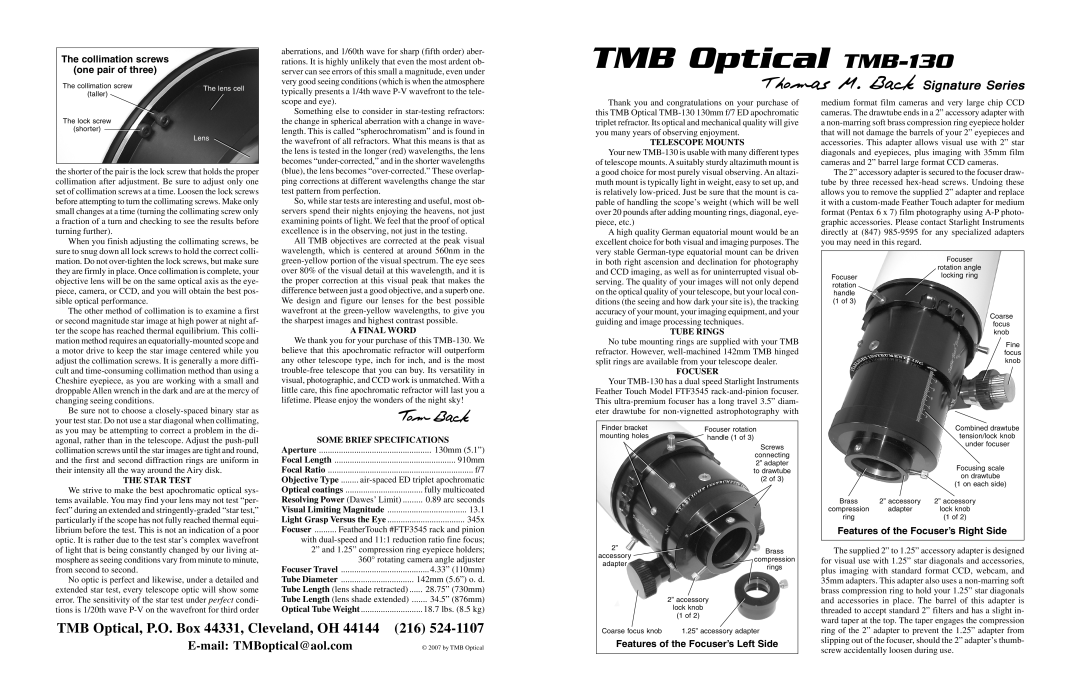
The collimation screws
(one pair of three)
The collimation screw | The lens cell | |
(taller) | ||
|
aberrations, and 1/60th wave for sharp (fifth order) aber- rations. It is highly unlikely that even the most ardent ob- server can see errors of this small a magnitude, even under very good seeing conditions (which is when the atmosphere typically presents a 1/4th wave
TMB Optical TMB-130
Thomas M. Back Signature Series
The lock screw |
(shorter) |
Lens |
the shorter of the pair is the lock screw that holds the proper collimation after adjustment. Be sure to adjust only one set of collimation screws at a time. Loosen the lock screws before attempting to turn the collimating screws. Make only small changes at a time (turning the collimating screw only a fraction of a turn and checking to see the results before turning further).
When you finish adjusting the collimating screws, be sure to snug down all lock screws to hold the correct colli-
scope and eye).
Something else to consider in
So, while star tests are interesting and useful, most ob- servers spend their nights enjoying the heavens, not just examining points of light. We feel that the proof of optical excellence is in the observing, not just in the testing.
All TMB objectives are corrected at the peak visual wavelength, which is centered at around 560nm in the
Thank you and congratulations on your purchase of this TMB Optical
TELESCOPE MOUNTS
Your new
A high quality German equatorial mount would be an excellent choice for both visual and imaging purposes. The very stable
medium format film cameras and very large chip CCD cameras. The drawtube ends in a 2” accessory adapter with a
The 2” accessory adapter is secured to the focuser draw- tube by three recessed
mation. Do not
The other method of collimation is to examine a first or second magnitude star image at high power at night af- ter the scope has reached thermal equilibrium. This colli- mation method requires an
Be sure not to choose a
A FINAL WORD
We thank you for your purchase of this
TomBack
in both right ascension and declination for photography and CCD imaging, as well as for uninterrupted visual ob- serving. The quality of your images will not only depend on the optical quality of your telescope, but your local con- ditions (the seeing and how dark your site is), the tracking accuracy of your mount, your imaging equipment, and your guiding and image processing techniques.
TUBE RINGS
No tube mounting rings are supplied with your TMB refractor. However,
FOCUSER
Your
Focuser rotation handle (1 of 3)
Focuser
rotation angle locking ring
Coarse focus knob
Fine focus knob
as you may be attempting to correct a problem in the di- agonal, rather than in the telescope. Adjust the
THE STAR TEST
We strive to make the best apochromatic optical sys- tems available. You may find your lens may not test “per- fect” during an extended and
No optic is perfect and likewise, under a detailed and extended star test, every telescope optic will show some error. The sensitivity of the star test under perfect condi- tions is 1/20th wave
SOME BRIEF SPECIFICATIONS
Aperture |
| 130mm (5.1”) | |
Focal Length |
| 910mm | |
Focal Ratio |
| f/7 | |
Objective Type | |||
Optical coatings | fully multicoated | ||
Resolving Power (Dawes’ Limit) | 0.89 arc seconds | ||
Visual Limiting Magnitude | 13.1 | ||
Light Grasp Versus the Eye | 345x | ||
Focuser | FeatherTouch #FTF3545 rack and pinion | ||
with
Focuser Travel | 4.33” (110mm) |
Tube Diameter | 142mm (5.6”) o. d. |
Tube Length (lens shade retracted) | 28.75” (730mm) |
Tube Length (lens shade extended) | 34.5” (876mm) |
Optical Tube Weight | 18.7 lbs. (8.5 kg) |
Finder bracket | Focuser rotation |
mounting holes | handle (1 of 3) |
| Screws |
| connecting |
| 2” adapter |
| to drawtube |
| (2 of 3) |
2” | Brass | |
accessory | ||
compression | ||
adapter | ||
rings | ||
|
2” accessory
lock knob (1 of 2)
|
| Combined drawtube |
|
| tension/lock knob |
|
| under focuser |
|
| Focusing scale |
|
| on drawtube |
|
| (1 on each side) |
Brass | 2” accessory | 2” accessory |
compression | adapter | lock knob |
ring |
| (1 of 2) |
Features of the Focuser’s Right Side
The supplied 2” to 1.25” accessory adapter is designed for visual use with 1.25” star diagonals and accessories, plus imaging with standard format CCD, webcam, and 35mm adapters. This adapter also uses a
TMB Optical, P.O. Box 44331, Cleveland, OH 44144 | (216) |
| © 2007 by TMB Optical |
Coarse focus knob | 1.25” accessory adapter |
Features of the Focuser’s Left Side
ring of the 2” adapter to prevent the 1.25” adapter from slipping out of the focuser, should the 2” adapter’s thumb- screw accidentally loosen during use.
